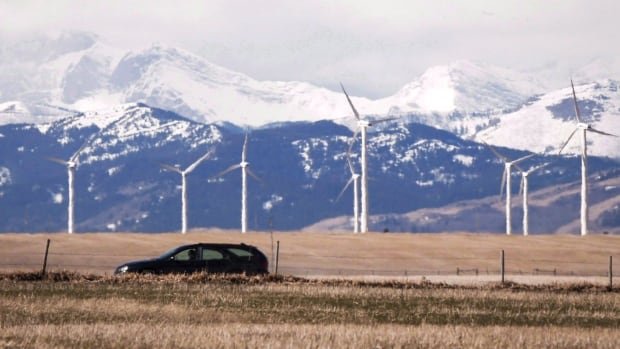They loomed over the landscape along the Crowsnest Highway, the 57 hulking wind turbines of the Cowley Ridge Wind Farm. This was the first commercial wind farm anywhere in Canada, erected in 1993 before being decommissioned eight years ago, replaced by a more efficient TransAlta-owned project slightly to the north.
With the Alberta government now declaring a ban on any new wind turbines within 35 kilometres of whatever the province deems “pristine viewscapes,” would this be allowed? Would Canada’s pioneering renewable energy project be kosher under Premier Danielle Smith’s new regime?
“My inability to answer that question is the problem here,” said Evan Wilson, policy vice-president with the Canadian Renewable Energy Association, in an interview Wednesday.
When taken to the policy’s most extreme interpretation of buffer zones “with a minimum of 35 kilometres” around all protected areas and designated viewscapes, most of southern Alberta would be off-limits. (Cowley Ridge is seven kilometres as the crow flies from Lundbreck Falls Provincial Recreation Area.)

It’s not clear the rule will be this restrictive — but even Nathan Neudorf, the utilities minister bringing in these plans, noted there is no “universal definition of pristine viewscape,” and details would have to be worked out.
Approvals of wind and solar energy developments have been frozen for seven months, and as this period formally ends on March 1, the province still needs time to figure out what it means by limits within viewscapes.
That’s what has groups advocating for renewable power antsy. After seven months with the sector’s fate left flapping in the air, there’s more uncertainty.
The Smith government “has now essentially introduced a second ‘soft moratorium,'” said Jorden Dye of the Business Renewable Centres-Canada.
Them’s the brakes
Nearly two decades ago, when then-premier Ed Stelmach was facing heat on the societal and environmental impacts of the rapidly expanding oilsands, he declared he didn’t believe in “touching the brakes.”
The current premier surprised businesses by slamming on the brakes when she was faced with another blossoming energy sector that critics said needed regulation. And with the brake now being lifted, businesses aren’t sure where they’re allowed to go.
Smith said further growth “must happen in well-defined and responsible ways.” Yet there’s much more yet to be defined, including the viewscape rules and forthcoming regulation changes to better cover the transmission costs to the wide-ranging renewable power farms. — and that’s a prospect industry leaders worry may add costs to existing wind or solar plants, in addition to new projects.
And there’s more of a potential crackdown yet to come on the power source its advocates tout as low-cost and plentiful, but which this UCP premier casts as unreliable and fraught with disadvantages.
Wednesday’s announcement was only part of the Smith-ordered review of wind and solar.
The next shoe to drop is on the overall market capacity for wind and solar, and action to back up Smith’s repeated declarations that the grid must add as much “reliable” power (natural gas, mostly) as it adds wind and solar, which cannot produce electricity 24/7/365.
They spoke the language of reassurance, with Smith saying “I don’t know how long it will take us before we end up constraining (development),” and Neudorf saying “there is no requirement for any of those proponents to add natural gas to their approvals” with these new rules.
But embedded into these remarks is the subtext that constraints and mandated gas-to-solar pairing are on the horizon.
This business is watching with what we can generously call anticipation to an hour-long speaking engagement by Neudorf on March 11 at an electricity producer conference in Banff.
As much anxiety as there has been about what Smith’s government was cooking up with this multibillion-dollar Alberta business, It’s not clear any of this yet spells doom for wind and solar in the province. Alberta’s natural advantages and its open-entry market still make it far easier for businesses to develop than in any other province, even as they ramp up their own renewables portfolios in government-controlled quantities.
More than 90 per cent of Canada’s new wind and solar development occurred in Alberta last year, and Smith expressed desire to keep the province a dominant player — even if she may also want to clip this low-carbon power sector’s wings a bit.
Wind and solar players say they can live with the new rules offering more municipal and neighbour input in hearings and (forthcoming) rules for reclamation. Meanwhile, limits on solar farms on top-class agricultural lands cover more than one-quarter of Alberta’s farmland, according to the government, although little of that is in the pasture-heavy southern Alberta, where electricity developers have flocked.
The province also offered power producers a glimmer of hope that it will finally open up government-owned Crown lands to wind and solar farms, which industry advocates say could offset newly restricted lands, especially in areas closer to existing transmission. But while many of these rules take place immediately (or as soon as Alberta figures them out), Crown access won’t happen until at least 2025.
It’s the murky “viewscape” rules that are drawing the most trepidation (thus far) about the sector’s ability to come roaring back post-moratorium.
“That’s going to make it harder to find suitable sites for this development, which means fewer projects are going to go ahead,” said Dan Balaban of Calgary-based renewable developer Greengate Power.
He has pulled back from pursuing expansions in Alberta since Smith’s moratorium, and he’s unsure about coming back yet, with more rules and regulations still yet to come.
The view from here
For a sense of how broad that 35-kilometre buffer is, it’s roughly the length of the full Deerfoot Trail from the north end of Calgary’s Stoney Trail ring road to its south end. That distance would span the entire Crowsnest Pass.
Pressed further to define “pristine viewscape,” Neudorf said the “Foothills and majestic Rocky Mountains are fairly significant.”
So is that declaring the gusty southwest Alberta a new moratorium zone?
He went on, talking about new mandates for “visual assessment” for towering wind turbines.
“Anything on the ridge is far more visible than it might be in a valley or a bluff,” Neudorf said.
So the third generation of Cowley Ridge won’t be allowed unless it’s hidden from view of potential naysayers?
When the Alberta Utilities Commission has reviewed proposed wind projects before, neighbours or landowners several kilometres away would protest the impact on their views. The commission would acknowledge that as a “consequence of the project that needs to be balanced against the project’s public benefits” — but the provincial policy would transform that calculus, and make viewscape impairment more of a deal breaker.

For generations, pumpjacks and oil wells came to dot the Alberta landscape as signs of prosperity and economic development. But they’ve never had the sort of geographical limits or landowner-consent issues facing renewables.
Wind turbines and fields of solar fields were starting to become part of the archetypal Alberta vista. But that was before government policy came to see them as blights on the provincial “viewscape.”
The same sort of business uncertainty, extended permitting hurdles and regulatory “red tape” that governments have lifted for other sectors is now imposed on this one — and the view from here to the future seems mightily obscured.










